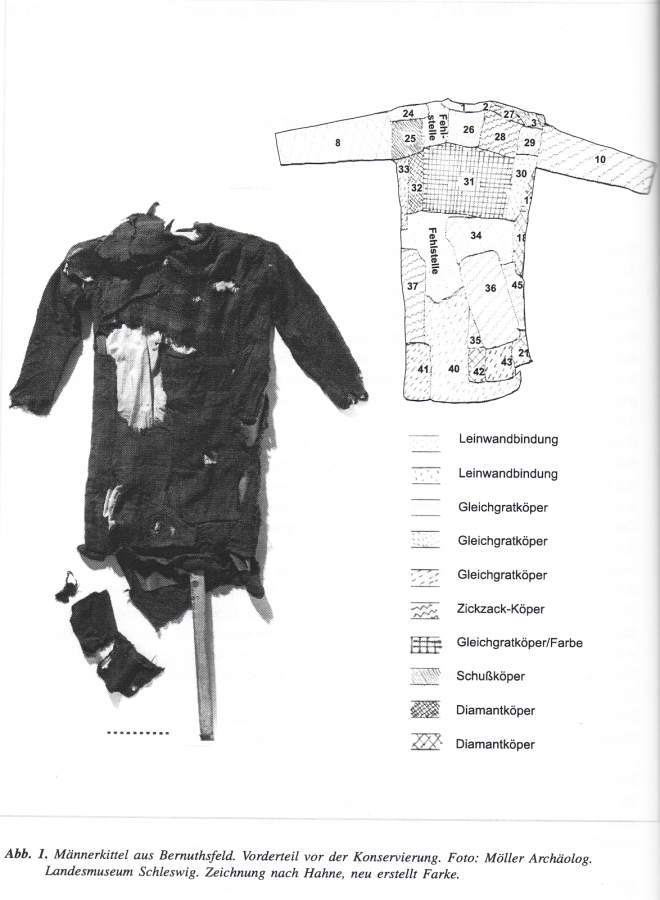Search the Blog
Latest Comments
Beatrix
Experiment!
23. April 2024
The video doesn´t work (at least for me). If I click on "activate" or the play-button it just disapp...
Katrin
Spinning Speed Ponderings, Part I.
15. April 2024
As far as I know, some fabrics do get washed before they are sold, and some might not be. But I can'...
Kareina
Spinning Speed Ponderings, Part I.
15. April 2024
I have seen you say few times that "no textile ever is finished before it's been wet and dried again...
Katrin
How on earth did they do it?
27. März 2024
Ah, that's good to know! I might have a look around just out of curiosity.
I've since learned that w...
Heather Athebyne
How on earth did they do it?
25. März 2024
...though not entirely easy. I've been able to get my hands on a few strands over the years for Geor...
More about the Bernuthsfeld Man.
The Bernuthsfeld Man's tunic is really a rather special affair - a very, very simple cut, but it is put together from only patches. It's not a heavily worn tunic that was patched up.
Most publications about the tunic are in German, including one published in one of the NESAT proceedings, which includes this overview picture of the tunic's front:
[caption id="attachment_3151" align="alignnone" width="640"] Picture from: Farke, Heidemarie. "Der Männerkittel aus Bernuthsfeld. Beobachtungen während einer Restaurierung." In Textiles in European Archaeology. Report from the 6th NESAT Symposium, 7-11th May 1996 in Borås, edited by Lise Bender Jørgensen and Christina Rinaldo, 99-106. Göteborg, 1998, p. 100.
Picture from: Farke, Heidemarie. "Der Männerkittel aus Bernuthsfeld. Beobachtungen während einer Restaurierung." In Textiles in European Archaeology. Report from the 6th NESAT Symposium, 7-11th May 1996 in Borås, edited by Lise Bender Jørgensen and Christina Rinaldo, 99-106. Göteborg, 1998, p. 100.
As you can see, it's rather... patchy. The individual bits of fabric all show marks of wear from previous use, possibly in garments; there's lots of twill variations and only rather few plain weave bits. My count is 19 different fabrics, used for 43 patches. Some of them are folded double, others are used as single layer. The "cut", if you can call it that without there having been proper garment cutting, is as simple as possible.
Why that tunic looks like it does? Nobody knows - it is a singular piece (alas, like quite a few textile finds). With its patches, possibly in different colours, but at least in very different kinds of fabric, all looking old and worn, and with the very conspicuous checkered fabric #31 right on the breast in front, it would have been very obvious that this was not a "normal" member of society, though. There are a few late medieval images that show beggars dressed in very, very patched garments - so maybe this tunic was a beggar's work clothing?
Most publications about the tunic are in German, including one published in one of the NESAT proceedings, which includes this overview picture of the tunic's front:
[caption id="attachment_3151" align="alignnone" width="640"]
 Picture from: Farke, Heidemarie. "Der Männerkittel aus Bernuthsfeld. Beobachtungen während einer Restaurierung." In Textiles in European Archaeology. Report from the 6th NESAT Symposium, 7-11th May 1996 in Borås, edited by Lise Bender Jørgensen and Christina Rinaldo, 99-106. Göteborg, 1998, p. 100.
Picture from: Farke, Heidemarie. "Der Männerkittel aus Bernuthsfeld. Beobachtungen während einer Restaurierung." In Textiles in European Archaeology. Report from the 6th NESAT Symposium, 7-11th May 1996 in Borås, edited by Lise Bender Jørgensen and Christina Rinaldo, 99-106. Göteborg, 1998, p. 100.As you can see, it's rather... patchy. The individual bits of fabric all show marks of wear from previous use, possibly in garments; there's lots of twill variations and only rather few plain weave bits. My count is 19 different fabrics, used for 43 patches. Some of them are folded double, others are used as single layer. The "cut", if you can call it that without there having been proper garment cutting, is as simple as possible.
Why that tunic looks like it does? Nobody knows - it is a singular piece (alas, like quite a few textile finds). With its patches, possibly in different colours, but at least in very different kinds of fabric, all looking old and worn, and with the very conspicuous checkered fabric #31 right on the breast in front, it would have been very obvious that this was not a "normal" member of society, though. There are a few late medieval images that show beggars dressed in very, very patched garments - so maybe this tunic was a beggar's work clothing?
Comments 2
Frisia Coast Trail
(website)
on Samstag, 31. August 2019 09:40
Great! Wasn't aware of this East Frisian piece of pallia! Mybe our blog post on pallia of interest: https://www.frisiacoasttrail.com/single-post/2018/06/01/Haute-Couture-from-the-salt-marshes
Frisia Coast Trail
(website)
on Samstag, 31. August 2019 09:43
Tried to reply before, but seemed not to work. Again, great to find this pallia of East Frisia! And maybe this blog post is of interest to you: https://www.frisiacoasttrail.com/single-post/2018/06/01/Haute-Couture-from-the-salt-marshes



